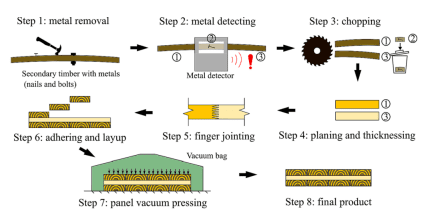Cross-Laminated secondary Timber: Validation of non-destructive Assessment of structural properties by full-scale bending tests

The demolition of buildings creates a vast quantity of secondary timber, which is currently chipped, downcycled or incinerated. This study examines a higher value use of secondary timber as lamellae for cross-laminated timber (CLT), which will address the increasing demand for wood products that is expected in the coming decades. The longitudinal vibration test method was used to determine the dynamic modulus of elasticity (dMoE) for secondary timber. Then, four-point bending tests were conducted for the secondary timber to obtain the static modulus of elasticity (sMoE) and modulus of rupture (MoR). The test results showed a good linear relationship between dMoE and sMoE, so the dMoE results could be used to predict sMoE of secondary timber. Furthermore, the static bending stiffness of cross-laminated secondary timber (CLST), sMoECL, was predicted by the dMoE from transverse vibration tests of CLST and longitudinal vibration tests of secondary timber. Four-point bending tests of CLST showed that the latter predicted sMoECL more accurately. CLST panels were also found to meet the structural requirements in relevant standards. Finally, analytical models were used to predict the bending stiffness and strength of CLST. The closest prediction came from combining the shear analogy method and bearing model for CLT. This paper demonstrates the feasibility of using secondary timber as a feedstock for CLT/CLST production.
